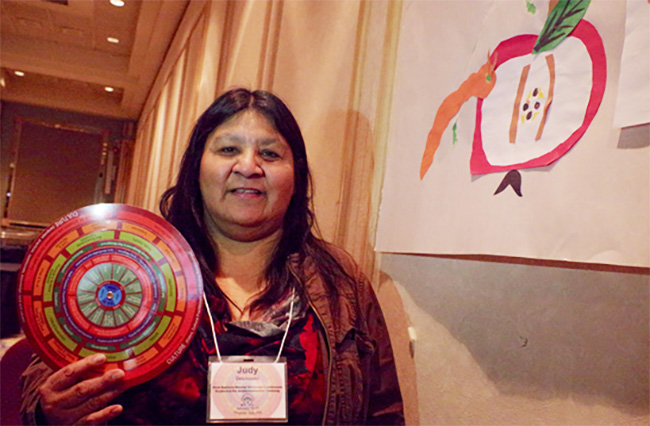Discussion continue with First Nations Mental Wellness in northern Ontario

By Rick Garrick
THUNDER BAY – The First Nations Mental Wellness Continuum Implementation training workshop, held Jan. 10-11 in Thunder Bay, featured information on how to use the First Nations Mental Wellness Continuum Model.
“I was part of contributing to this (First Nations Mental Wellness Continuum Framework) before it actually became a tool,” says Judy Desmoulin, Long Lake #58’s health and social director. “It looks like a busy tool, but once you get to understand it, it’s quite a helpful tool. I like the way it starts off with having meaning, purpose, hope and belonging. That’s the core of what every human being needs: they need to belong, they need to have some hope, they need to have some meaning to their life. So this is kind of like the core — everything else expands from there.”
Desmoulin was one of about 35 First Nation representatives from across northern Ontario who participated in the training workshop, which was held by the Thunderbird Partnership Foundation at the Valhalla Inn. Other training workshops were scheduled for Jan. 10-11 in Toronto and Jan. 17-18 in Sault Ste. Marie.
“In this training, they are giving us some really good practical ways to deliver it and to explain it,” Desmoulin says, noting that three Long Lake #58 representatives attended the training workshop. “Overall, using this tool, this is something that we’ve always been doing in our community without seeing it this way.”
Nora Bressette, curriculum coordinator with the Thunderbird Partnership Foundation, says the training workshop included a variety of activities and ideas for the First Nation representatives about how to utilize and implement the First Nations Mental Wellness Continuum Framework Model.
“Yesterday we did an activity on see, run and do to teach them about what are some of the challenges and barriers and things they may have to overcome,” Bressette says. “And today the practice we are doing is what are some of the protocols and things they need to put in place when they implement different kinds of Indigenous practices and programs within their communities.”
Bressette says the First Nations Mental Wellness Continuum Framework was developed with input from First Nation communities, treatment centres, Elders and healers and researchers from across Canada.
“It is culturally based and it is also very strength based, which means we are not focusing so much on the deficits of our people,” Bressette says. “We are looking what are the strengths of our people and helping our people to move ahead in a very positive way.”
Jasmine Fournier, Indigenous knowledge exchange and research coordinator with the Thunderbird Partnership Foundation, says hope, belonging, meaning and purpose is at the centre of the First Nations Mental Wellness Continuum Framework.
“Focusing on these four key elements helps promote wellness in a holistic sense through a strength-based process,” Fournier says.
Fournier enjoyed working with the participants during the training workshop.
“They are really engaged and really happy,” Fournier says. “There is lots of laughter. Laughter is the best medicine, so it is great to hear the framework being taken up.”
The first day of the training workshop included information on the background of the First Nations Mental Wellness Continuum Framework and the development of long-term goals for wellbeing in communities. The second day included information on how to implement culture throughout the programming for mental wellness, restorative justice in Indigenous communities and the developmental stages of life through an Indigenous perspective.
Information about the First Nations Mental Wellness Continuum Framework is available online at: thunderbirdpf.org.


